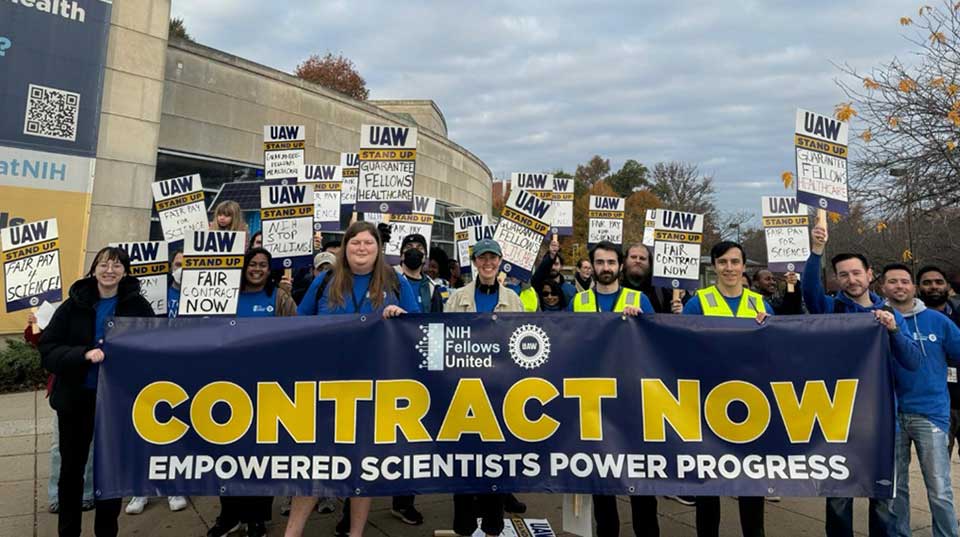
BETHESDA, Md.—Lagging pay in a high-cost metro area. Threatened end of health care coverage in about a year. Sexual harassment and favoritism on the job. No job security.
These key issues drove top post-graduate, post-baccalaureate, and post-doctoral scientific researchers into an informational picket line against their bosses at the world-renowned National Institutes of Health, during the morning rush hour on October 29.
Two groups of researchers, one at the D.C. subway’s NIH station and the other stationed at the bus turnoff along neighboring Wisconsin Avenue, a major commuter route, drew appreciative honks from passing drivers, and smiles from subway passengers entering the NIH complex, taking the small summary flyers the researchers distributed.
The 4,800 researchers, some of the brightest young people in the medical sciences, unionized last year with the NIH Fellows United/UAW. They’re a part of UAW’s push into non-automotive fields—so much so that more than half of its members now work in areas other than vehicles and their parts. The academic sector is the fastest-growing.
The NIH researchers work on a wide range of health care and scientific issues, from seeking cures for cancer to sequencing the human genome to analytical chemistry to—during the coronavirus pandemic—accelerated development of vaccines against that modern-day plague.
The NIH researchers are among the millions of underpaid, overworked people workers facing corporate greed, even though they work for a federal agency. Like fast food workers, adjunct professors, warehouse workers, port truckers, and others, they’ve had it with exploitation.
So those exploited workers walk—an option unavailable to the NIH researchers in this highly competitive academic field—or unionize, or both.
Exploitation particularly hurts when they love what they do, and they believe in their cause: Biomedical research into ways to cure humankind’s myriad and devastating illnesses. “We’re passionate and dedicated,” human genome researcher Shariar Zamani told People’s World. “But so many have to leave the workplace.”
Zamani, backed by a bargaining committee researcher who did not want to be named due to worries about retribution, said a key point is that NIH’s pay “has lagged behind the rising cost of living,” as he put it. “It’s also difficult to put savings aside,” for subsequent medical careers.
The bargainer, interviewed previously, said 40% of the researchers “are being paid less than the living wage calculator” for the Washington metropolitan area.
Living wage must be higher
Compiled by the Massachusetts Institute of Technology, that calculator says the living wage for a D.C.-area resident ranges from $24 hourly for a single adult with no children to $38.31 hourly for two working adults with three children.
Having a family is difficult, said National Cancer Institute researcher Ian Fucci and his spouse, Erika, who held a private-sector healthcare research job she left to become “a stay-at-home mom.” But just their first year of child care for their three-year-old daughter Nora—who was perched atop her daddy’s head and shoulders during the picketing–“cost $20,000.”
And now, said Fucci, NIH management told the union that it will end NIH-paid health care for the researchers when the government’s Fiscal 2025 ends at the end of September.
“That’s really scary,” he says.
NIH bosses tried another tactic, raising the pay of other researchers when the group went public with its organizing drive last year, “We at the cancer institute were making $10,000 more in salary per year” than the other researchers, Fucci elaborated. “After we unionized, NIH increased the stipends of the others by $10,000.”
That’s because, as ordered by Congress and succeeding administrations, finding a cure for cancer has been a top NIH priority for decades.
Haley Chatelaine, who researches analytical chemistry, later chimed in that management negotiators then claimed in bargaining, “We already gave you increases. Why are you asking for more?”
And NIH bans its researchers from taking second, part-time, jobs to make ends meet. “The only way to make extra money is to volunteer” to participate “in NIH clinical trials,” which offer reimbursements, Chatelaine noted.
Besides, Chatelaine added, that increasing pay and awarding research contracts longer than year-to-year would increase diversity. Though many are non-white, a huge share of those are on U.S. visas reserved for specialized workers. The visa holders are 30% of all the researchers.
With tenure for the following year unsure until the end of an academic year, those on visas—at NIH, other major medical centers and top research universities–are also on tenterhooks. No job equals no visa equals a return to your homeland. Writing a union contract that protects them, by making the NIH fellowships last more than a year at a time, is a top priority.
Combatting sexual discrimination and harassment is also a big goal in the union’s past talks with NIH. The bargainer said sexual harassment in academia is second only to that of the military—and Congress stepped in there to divorce harassment hearings and decisions from the chain of command.
“In academic research, sexual harassment has been a longstanding problem,” and it’s now a big issue for the researchers and their union, said Zaman. “We need an independent body to help them navigate” the cases of harassment and worse “and an independent arbitrator to decide them.”










